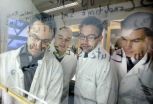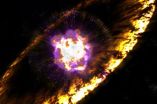(Press-News.org) We are constantly being bombarded by speedy, energetic, and yet unassuming, particles called cosmic rays. These charged particles (mostly protons), continuously assail the Earth from outer space. There is general consensus among scientists that supernova remnants (the leftovers of a supernova explosion) are the sources of cosmic rays, but the final proof has been elusive since cosmic rays are deflected on their way from the source to Earth.
A new study offers conclusive evidence that cosmic ray protons within our galaxy are accelerated in the shock waves produced by supernovae. The research appears in the February 15 2013 issue of the journal Science.
"For the first time were able to detect the 'smoking gun' feature of the accelerated protons, that is, the spectral cutoff in the gamma ray spectrum due to the decay of neutral pions," said Stefan Funk, assistant professor of physics at Stanford University and co-author of the study.
Pions are subatomic particles produced when accelerated cosmic rays interact with the interstellar material surrounding supernovae. Pions quickly decay into gamma rays which can then be detected with special telescopes.
The problem is that there are multiple processes in the Universe that produce gamma rays. When gamma rays enter in a detector, scientists are unable to determine if these rays have been created by high-energy protons or by high-energy electrons.
Stefan Funk and a team of researchers spent four years (from 2008 to 2012) observing gamma rays with the Large Area Telescope (LAT), which sits onboard the Fermi Gamma-ray Space Telescope. They observed two supernova remnants named IC 433 and W44. Both are located within in our galaxy – IC 443 is roughly 5,000 light years away from Earth in the constellation Gemini, while W44 is located about 10,000 light years away, in the constellation of Aquila.
Analyzing the data, the researchers spotted the characteristic signature of neutral pion decay in the gamma ray spectrum, which unambiguously connects gamma rays to accelerated protons in supernova remnants.
"While we have demonstrated that supernova remnants accelerate cosmic rays, the next step will be to determine exactly they do it, and also up to what energies they can do so," said Funk.
###
Fermi LAT data related to this research is available from the Fermi Science Support Center.
Please note that this work will be the subject of a 9:00 a.m. US EST news briefing on 2/14 at the AAAS Annual Meeting in Boston. Reporters who are registered for SciPak can access the briefing via our Annual Meeting Virtual Newsroom at: http://www.eurekalert.org/aaasnewsroom/.
The Fermi LAT Collaboration acknowledges support from a number of agencies and institutes for both development and the operation of the LAT as well as scientific data analysis. These include NASA and DOE in the United States, CEA/Irfu and IN2P3/CNRS in France, ASI and INFN in Italy, MEXT, KEK, and JAXA in Japan, and the K. A. Wallenberg Foundation, the Swedish Research Council and the National Space Board in Sweden. The work received additional support from INAF in Italy and CNES in France for science analysis during the operations phase.
The American Association for the Advancement of Science (AAAS) is the world's largest general scientific society, and publisher of the journal, Science as well as Science Translational Medicine and Science Signaling. AAAS was founded in 1848, and includes some 261 affiliated societies and academies of science, serving 10 million individuals. Science has the largest paid circulation of any peer-reviewed general science journal in the world, with an estimated total readership of 1 million. The non-profit AAAS is open to all and fulfills its mission to "advance science and serve society" through initiatives in science policy; international programs; science education; and more. For the latest research news, log onto EurekAlert!, www.eurekalert.org, the premier science-news Web site, a service of AAAS.
END
Anxiety-moderating drugs that reach waterways via wastewater create fearless and asocial fish that eat more quickly than normal. These behavioral changes can have serious ecological consequences. This is shown by Umeå University researchers in the prestigious journal Science.
Many drugs leave our bodies unaffected, and residues from them are therefore found in wastewater. Low concentrations of drugs are often found downstream from sewage treatment plants. Today we test how dangerous drugs are to humans, but our knowledge of the environmental impacts of drugs is limited. ...
Pharmaceutical drugs that end up in the world's waterways after being excreted, flushed and treated at wastewater treatment plants may lead to unexpected ecological impacts, according to a new study of wild European perch. Tomas Brodin and colleagues from Umeå University in Sweden discovered that the fish ate faster, became bolder and acted less social after being subjected to an anxiety-moderating drug, known as Oxazepam.
The psychiatric drug is used to treat anxiety in humans. But, Oxazepam residues often wind up in natural aquatic systems, downstream from sewage treatment ...
Menlo Park, Calif. — A new study confirms what scientists have long suspected: Cosmic rays – energetic particles that pelt Earth from all directions – are born in the violent aftermath of supernovas, exploding stars throughout the galaxy.
A research team led by scientists at the Kavli Institute for Particle Astrophysics and Cosmology at the Department of Energy's (DOE) SLAC National Accelerator Laboratory sifted through four years of data from NASA's Fermi Gamma-ray Space Telescope to find the first unambiguous evidence of how cosmic rays are born.
Reporting in the ...
This press release is available in German.
Bremerhaven, 14 February 2013. Huge quantities of algae are growing on the underside of sea ice in the Central Arctic: in 2012 the ice algae Melosira arctica was responsible for almost half the primary production in this area. When the ice melts, as was the case during the ice minimum in 2012, these algae sink rapidly to the bottom of the sea at a depth of several thousands of metres. Deep sea animals such as sea cucumbers and brittle stars feed on the algae, and bacteria metabolise what's left, consuming the oxygen in the ...
DARIEN, IL – A new study confirms a link between insomnia and thoughts of suicide and suggests that this relationship is mediated by dysfunctional beliefs and attitudes about sleep as well as nightmares. The study suggests that the targeted assessment and treatment of specific sleep problems may reduce the risk of suicide in people with depressive symptoms.
"Insomnia and nightmares, which are often confused and go hand-in-hand, are known risk factors for suicide but just how they contribute was unknown," said Dr. W. Vaughn McCall, the study's lead author and chair of ...
BOSTON – The trolls are winning.
Pick a story about some aspect of science, any story, scroll down to the blog comments and let the bashing begin:
"Wonder how much taxpayer cash went into this 'deep' study?"
"I think you can take all these studies by pointy headed scientists, 99 percent of whom are socialists and communists, and stick them where the sun don't shine."
"Yawn. Climate change myth wackos at it again."
"This article is 100 percent propaganda crapola."
"Speaking of dolts, if you were around in the 70s, when they also had scientists, the big talk ...
Even in the presence of screening, there is benefit to radical prostatectomy (RP) in prostate cancer patients, however, the benefit is limited to a subgroup of patients and can take years to become evident according to a study published February 14 in the Journal of the National Cancer Institute.
The Scandinavian Prostate Cancer Group Study Number 4 (SPCG-4) trial identified that RP lowered prostate cancer deaths with a statistically significant absolute mortality difference (AMD) between RP and watchful waiting (WW) of 6.1%. The Prostate Cancer Intervention Versus Observation ...
FINANCIAL DISCLOSURE: CJ was funded by a grant from the Agence Nationale de la Recherche (projet n_ BLAN06-3_141806). The funders had no role in study design, data collection and analysis, decision to publish, or preparation of the manuscript.
COMPETING INTEREST: The authors have declared that no competing interests exist.
PLEASE ADD THIS LINK TO THE PUBLISHED ARTICLE IN ONLINE VERSIONS OF YOUR REPORT:
http://dx.plos.org/10.1371/journal.ppat.1003178
(link will go live upon embargo lift)
CITATION: Johnston C, Martin B, Granadel C, Polard P, Claverys J-P (2013) Programmed ...
(Boston) – Researchers from the Boston University School of Medicine (BUSM) and Boston University School of Public Health (BUSPH) have shown that alcohol is a major contributor to cancer deaths and years of potential life lost. These findings, published in the April 2013 issue of the American Journal of Public Health, also show that reducing alcohol consumption is an important cancer prevention strategy as alcohol is a known carcinogen even when consumed in small quantities.
Previous studies consistently have shown that alcohol consumption is a significant risk factor ...
In a study of mice, researchers at Johns Hopkins have identified a new molecular pathway involved in the growth of tiny air sacs called alveoli that are crucial for breathing. The scientists say their experiments may lead to the first successful treatments to regrow the air sacs in people who suffer from diseases such as emphysema in which the air sacs have been destroyed by years of smoking. The work may also suggest new therapy for premature infants born before their lungs are fully developed.
"One of the most daunting challenges we face as physicians is helping patients ...


